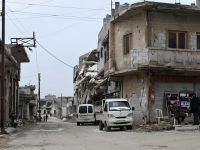Residents fleeing the erupting Mayon volcano in the Philippines swelled past 32,000 Monday as the crater simmered a day after a series of massive blasts, officials said.
Thin smoke rose from the crater of the mountain in the central region of Bicol, as evacuees arrived at packed government schools beyond the eight-kilometer (five-mile) danger zone declared by the government.
No casualties were reported. Local officials say people are well-drilled and cooperative after enduring frequent eruptions. Up to 80,000 people were displaced in February 2000.
The civil defense office said 32,686 people had been crammed into 15 schools beyond the lava's reach since Mayon began erupting again at the weekend.
"We have a lull in the activity of Mount Mayon but it is still in eruption because the lava flow is still going down," said Raymundo Punongbayan, director of the Philippine Institute of Volcanology and Seismology (Phivolcs).
He warned that Mayon could still stage another explosive eruption like the one on Sunday that sent a sulfuric cloud about 10 kilometers (six miles) into the air.
Poor visibility caused by volcanic ash clouds forced the cancellation of Philippine Airlines flights to Legaspi, the nearest city to Mayon, until at least July 1.
Government and private relief workers were taking advantage of the lull in eruption activity to boost supplies and erect sanitation facilities for the evacuees.
Civil defense officials said there were concerns at the congested evacuation centers about the supply of drinking water, sanitary toilets and the storage of relief goods.
Defense Secretary Angelo Reyes, head of the civil defense office, visited the area with other cabinet officials and assured residents a large water purifier was being brought in for evacuation centers and relief supplies and funds were ready to be released.
But Cedric Daep, the provincial disaster management chief, said the combined food supplies of the national and provincial governments would sustain the evacuees for just two weeks.
Many evacuees complained they were getting only one ration allowance a day.
Based on previous activity, vulcanologists say Mayon's eruption could last one to two weeks.
Chief vulcanologist Ernesto Corpuz said sensors recorded tremors on the 2,467-meter (8,141-feet) mountain overnight, indicating that magma was still rising and "more explosions and lava flows are expected."
Lava was flowing down eight river channels and had reached five kilometers (three miles) downstream by Monday, he said. Legaspi is well beyond the lava flow, but villages on the volcano's foothills have been declared off-limits -- LEGASPI, Philippine (AFP)
© 2001 Al Bawaba (www.albawaba.com)







